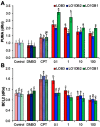Uptake of Flaxseed Dietary Linusorbs Modulates Regulatory Genes Including Induction of Heat Shock Proteins and Apoptosis
- PMID: 36496568
- PMCID: PMC9741104
- DOI: 10.3390/foods11233761
Uptake of Flaxseed Dietary Linusorbs Modulates Regulatory Genes Including Induction of Heat Shock Proteins and Apoptosis
Abstract
Flaxseed (Linum usitatissimum L.) is gaining popularity as a superfood due to its health-promoting properties. Mature flax grain includes an array of biologically active cyclic peptides or linusorbs (LOs, also known as cyclolinopeptides) that are synthesized from three or more ribosome-derived precursors. Two flaxseed orbitides, [1-9-NαC]-linusorb B3 and [1-9-NαC]-linusorb B2, suppress immunity, induce apoptosis in a cell line derived from human epithelial cancer cells (Calu-3), and inhibit T-cell proliferation, but the mechanism of LO action is unknown. LO-induced changes in gene expression in both nematode cultures and human cancer cell lines indicate that LOs promoted apoptosis. Specific evidence of LO bioactivity included: (1) distribution of LOs throughout the organism after flaxseed consumption; (2) induction of heat shock protein (HSP) 70A, an indicator of stress; (3) induction of apoptosis in Calu-3 cells; and (4) modulation of regulatory genes (determined by microarray analysis). In specific cancer cells, LOs induced apoptosis as well as HSPs in nematodes. The uptake of LOs from dietary sources indicates that these compounds might be suitable as delivery platforms for a variety of biologically active molecules for cancer therapy.
Keywords: anti-cancer; apoptosis; cyclic peptide; flaxseed; heat shock protein; linusorb.
Conflict of interest statement
M.J.T.R. is the founder of, and has an equity interest in, Prairie Tide Diversified Inc. (PTD, Saskatoon, SK, Canada). Y.Y.S. is the Korea Branch Representative for PTD in Korea. The terms of this arrangement have been reviewed and approved by the University of Saskatchewan in accordance with its conflict-of-interest policies. Other authors declare no conflict of interest.
Figures




Similar articles
-
Health benefits of flaxseed and its peptides (linusorbs).Crit Rev Food Sci Nutr. 2024;64(7):1845-1864. doi: 10.1080/10408398.2022.2119363. Epub 2022 Oct 4. Crit Rev Food Sci Nutr. 2024. PMID: 36193986
-
Non-oxidized and oxidized flaxseed orbitides differently induce HepG2 cell apoptosis: involvement of cellular uptake and membrane death receptor DR4.J Sci Food Agric. 2024 May;104(7):4296-4308. doi: 10.1002/jsfa.13315. Epub 2024 Mar 3. J Sci Food Agric. 2024. PMID: 38433335
-
Oxidative Stability of Novel Peptides (Linusorbs) in Flaxseed Meal-Fortified Gluten-Free Bread.Foods. 2025 Jan 29;14(3):439. doi: 10.3390/foods14030439. Foods. 2025. PMID: 39942031 Free PMC article.
-
Flaxseed orbitides, linusorbs, inhibit LPS-induced THP-1 macrophage inflammation.RSC Adv. 2020 Jun 15;10(38):22622-22630. doi: 10.1039/c9ra09058d. eCollection 2020 Jun 10. RSC Adv. 2020. PMID: 35514549 Free PMC article.
-
Flaxseed Peptides and Cyclolinopeptides: A Critical Review on Proteomic Approaches, Biological Activity, and Future Perspectives.J Agric Food Chem. 2022 Nov 23;70(46):14600-14612. doi: 10.1021/acs.jafc.2c06769. Epub 2022 Nov 10. J Agric Food Chem. 2022. PMID: 36355404 Review.
Cited by
-
Research progress on peptides that inhibit melanin synthesis.Front Pharmacol. 2025 Jul 2;16:1610623. doi: 10.3389/fphar.2025.1610623. eCollection 2025. Front Pharmacol. 2025. PMID: 40672371 Free PMC article. Review.
-
Anticancer Potential of the Cyclolinopeptides.Cancers (Basel). 2023 Jul 30;15(15):3874. doi: 10.3390/cancers15153874. Cancers (Basel). 2023. PMID: 37568690 Free PMC article. Review.
-
Vitexin Regulates Heat Shock Protein Expression by Modulating ROS Levels Thereby Protecting against Heat-Stress-Induced Apoptosis.Molecules. 2023 Nov 17;28(22):7639. doi: 10.3390/molecules28227639. Molecules. 2023. PMID: 38005362 Free PMC article.
-
Anti-Oxidant and Anti-Cancer Properties of Flaxseed.Int J Mol Sci. 2025 Jan 30;26(3):1226. doi: 10.3390/ijms26031226. Int J Mol Sci. 2025. PMID: 39940995 Free PMC article. Review.
References
-
- Shim Y.Y., Gui B., Arnison P.G., Wang Y., Reaney M.J.T. Flaxseed (Linum usitatissimum L.) bioactive compounds and peptide nomenclature: A review. Trends Food Sci. Technol. 2014;38:5–20. doi: 10.1016/j.tifs.2014.03.011. - DOI
-
- Kaufmann H.P., Tobschirbel A. Über ein Oligopeptid aus Leinsamen. Chem. Ber.-Recl. 1959;92:2805–2809. doi: 10.1002/cber.19590921122. - DOI
-
- Morita H., Shishido A., Matsumoto T., Takeya K., Itokawa H., Hirano T., Oka K. A new immunosuppressive cyclic nonapeptide, cyclolinopeptide B from Linum usitatissimum. Bioorg. Med. Chem. Lett. 1997;7:1269–1272. doi: 10.1016/S0960-894X(97)00206-0. - DOI
-
- Morita H., Kayashita T., Takeya K., Itokawa H., Shiro M. Conformation of cyclic heptapeptides: Solid and solution state conformation of yunnanin A. Tetrahedron. 1997;53:1607–1616. doi: 10.1016/S0040-4020(96)01098-8. - DOI
-
- Morita H., Shishido A., Matsumoto T., Itokawa H., Takeya K. Cyclolinopeptides B-E, new cyclic peptides from Linum usitatissimum. Tetrahedron. 1999;55:967–976. doi: 10.1016/S0040-4020(98)01086-2. - DOI
Grants and funding
LinkOut - more resources
Full Text Sources

